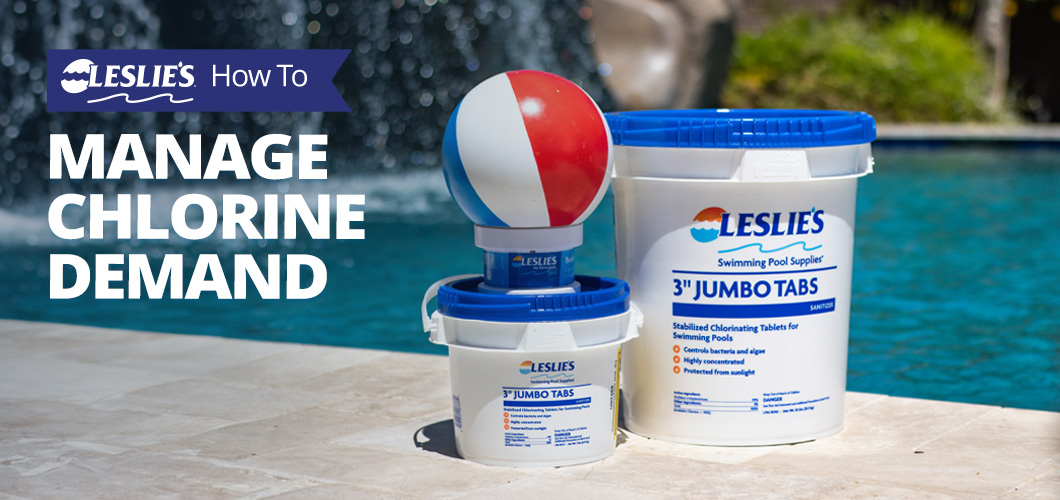
How to Manage Chlorine Demand
Does it seem like you're constantly pouring chlorine in the pool? If Free Available Chlorine levels in your swimming pool are chronically low, or if your water test results seem way off, it's time to investigate further. Many people use the terms "chlorine lock" and "chlorine demand" interchangeably. However, the water chemistry problem you're dealing with is actually high chlorine demand. In this post, we'll take a closer look at what is chlorine demand, how to resolve chlorine inadequacies in your pool, and how to keep ahead of chlorine demand in the first place.
What is Chlorine Demand?
Chlorine demand is a measure of the amount of chlorine required by your pool. Free Available Chlorine (FAC), also known as residual chlorine, is the amount of chlorine that remains after the chlorine demand is met. When you’re unable to maintain an FAC residual despite repeated applications of chlorine, odds are that your pool is simply consuming chlorine faster than it can be added. The chlorine's not locked up, it's just being consumed too quickly.

As contaminants are oxidized, the chlorine in your pool is partially destroyed or reduced. Direct sunlight, aeration/misting from water features, dilution, splashing, rain contaminants, and a low pH or Cyanuric Acid level also use up or dissipate the chlorine more quickly. The goal for any pool owner is to keep chlorine demand as low as possible to maintain a sufficient FAC residual at all times. This will ensure your water stays properly sanitized. Here are a few of the most common causes of high chlorine demand:
- Algae growth
- Rainwater
- Air pollution
- Microorganisms, including bacteria, protozoa, fungus, and other germs
- Organic contaminants, including cosmetics and sunscreen
- Bather wastes, including sweat, urine, fecal matter, dead skin, body oils, and hair
- Organic buildup in pool plumbing, especially if you're not using enzymes
- Lawn clippings, fertilizers, weed killers, leaves, dirt, pollen, bugs, and other debris from around your yard
- Animal waste, such as dog dander or bird droppings
BONUS TIP: Using alternative sanitizers in addition to your primary chlorine sanitizer can help decrease the chlorine demand in your pool. For example, mineral systems, UV light, and ozonators all work in conjunction with your chlorine to maximize sanitization efficiency.
How Do You Fix Chlorine Demand?
The best way to fix a chlorine-hungry pool is to feed it more of what it wants — chlorine!

Keep the Pool Sanitized
Shock the pool at least once per week for best results. Shock more frequently if your pool experiences a weather event or has high number of swimmers. The type of shock you use depends on the amount of Free Available Chlorine (FAC) in your pool. If levels are at 2.0 ppm or higher, use a chlorine-free shock like Leslie's Fresh 'N Clear to oxidize the water and break down chloramines. If levels are lower than that, use a chlorinated shock, such as Leslie's Power Powder Plus 73 or Leslie's Chlor Brite.
When shocking the pool, start with well-balanced water so your pool shock can work most effectively. Remember to keep the pump running to circulate the water until chlorine levels return to the ideal 1.0–4.0 ppm range, and don't swim while levels are still high.
Between weekly shock treatments, use an automatic or floating chlorinator to ensure a continuous stream of chlorine that exceeds chlorine demand. If using a saltwater chlorine generator or automatic inline/offline chlorine feeder, make sure your pump run time is adequate to produce the needed sanitizer levels. This time will go up the warmer the weather gets. A floating chlorinator will provide 24/7 chlorination, but may require additional tablets during warmer temperatures.
Use Specialty Chemicals
Consider using Leslie’s Perfect Weekly to help keep chlorine demand in check. Perfect Weekly is a powerful 3-in-1 phosphate remover, pool enzyme, and solar cover treatment that will help maximize chlorine efficiency in your pool. Without phosphates in the water, it’s harder for algae to grow. In addition, the enzymes in Perfect Weekly target non-living organic debris in the water, allowing your chlorine to focus on living contaminants, which helps it last longer in the water. The reduction in evaporation can also contribute to water and chemical savings.
Maintain Your Pool
Other tips to decrease chlorine demand include:
- Ensure adequate circulation/filtration run times
- Clean your pool filter as needed
- Keep the pool brushed and clean
- Limit pets from using the pool
- Keep the deck and pool toys clean
- When cleaning the deck, direct the water outward away from the pool
- Ensure skimmers have functional weir gates
- Keep skimmer and pump baskets clean
- Have swimmers shower before entering the pool
- Ensure proper water balance — Total Alkalinity, pH, Calcium Hardness, Cyanuric Acid, and more
BONUS TIP: Did you know your water chemistry plays a direct role in the efficacy and longevity of your chlorine? For example, a high pH can reduce chlorine's ability to sanitize, while a low pH may cause chlorine to dissipate more quickly from your pool. Test and balance the water often to keep the chemistry in range, so your pool stays clean, safe, and beautiful.
Leslie's Can Help!
Need help correcting your pool water problems? Just bring a water sample to your local Leslie’s. In as little as 60 seconds, you’ll have a complete 10-point water analysis and customized treatment plan with detailed step-by-step instructions on how to balance and maintain your pool water. The best part? Our in-store AccuBlue® experience is completely FREE. You'll be back to a clean, safe, and beautiful pool in no time with a little help from Leslie's.